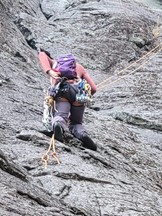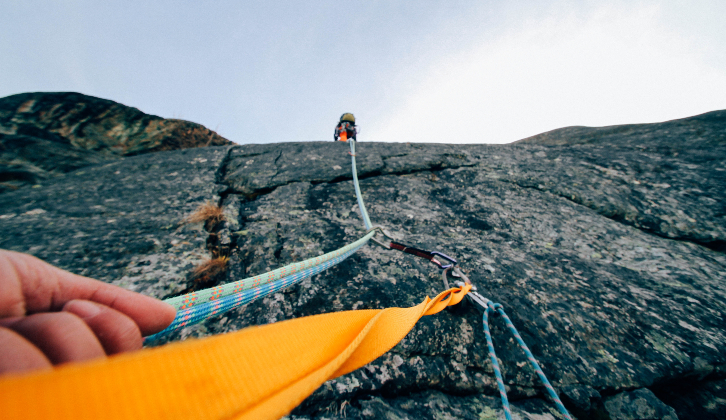I just got back from rock climbing in the Blue Ridge Mountains in North Carolina. It was amazing!
One day, I was lead climbing a route that was supposed to be on the easier side of moderate. But at one point, I got off route and followed the wrong line by accident. I ended up on a 5.10-rated climb, which is way above my leading ability. Gulp!
This kind of thing can be life-threateningly dangerous, so I really needed to course correct. I ran through the options that made the most sense and, long story short, none of them were possible in these specific circumstances.
So, there I was, clinging to a mountain on tiny footholds wondering what to do. I was mid-way through the second pitch, so my 60m rope wasn’t long enough to reach the ground for a normal rappel. So, I used a fixed bolt from an adjacent route to do an intermediate rappel to another fixed bolt, and as you can see in the picture, I was literally at the end of my rope at that point in the process. From there, I rappelled down to safety on the ground.

What enabled me to devise that solution? Well, one of the things I always keep on my harness is a “bail kit” which helps climbers escape from a situation they don’t want to be in.
This is actually something I learned when I took a rescue course back in the day. (In other words, a “bail kit” isn’t necessarily common practice.) Thanks to some webbing and portable rappel rings on my bail kit, I was able to improvise a safe rappel down.
But here’s the thing: I didn’t panic. Yes, I was acutely aware I was in a dangerous situation, but even as some four-letter words admittedly escaped by mouth, my heart wasn’t racing and my brain wasn’t spinning.
So why am I telling you this?
Because the steps I went through are the same steps I’d go through in an “oh crap!” corporate situation, too. Let’s break them down:
- When you get into a tricky situation, don’t panic. Keep a clear head and evaluate your options.
- Once you decide, put safety measures into place. In the case of rock climbing, it’s tying knots at the end of the rope. This is one of the steps I took when repelling down. I needed to make sure I wouldn’t accidentally run out of rope and fall off the mountain. In an organizational context, ask yourself: What measures can I put into place so that — if the worst-case scenario happens — I am as equipped as possible to succeed?
- Go into every project with a safety net or a backup plan. For me, that was my “bail kit.” In a corporate situation, it could be a plan B strategy if plan A doesn’t work or a well-conceived contingency plan in case of an unexpected crisis.
- Keep constant communication. Always. But especially in a crisis. My climbing partner was supporting me and brainstorming options with me the whole time. In a corporate predicament, transparency and asking for help is always the way to go even though it may feel humbling in the moment.
- Be proactive about acquiring the right training. For me, that was taking a rescue course when I got serious about climbing. From a corporate perspective, we all need to continuously develop the competencies to be agile and decisive in this volatile, uncertain, complex and ambiguous, or VUCA, world.
Tactical readiness isn’t enough. Build your cognitive readiness, too
The above steps are vital, but having a tactical crisis plan is only half the battle. There’s also a cognitive component. But what is cognitive readiness and why is it really important?
First up, what is it? It’s having the mental preparation to activate when you’re faced with a complex and/or unpredictable situation.
At work, common situations for which we may not be mentally prepared include the sudden rise of a new competitor that blows up a big part of your business, having to unexpectedly lay off good people on your team or executing an urgent worldwide product recall.
At home, it might be fight, flight, or freeze reactions that throw us off our mental and emotional games, such as being served divorce papers out of the blue, a death in the family or of a close friend, a car accident, or any other destabilizing personal circumstance that you can’t help but bring to work in some way.
In the story above, I shared how I remained levelheaded so I didn’t die on that mountain. First and foremost, I had taken a rescue class (not required to rock climb), and I learned a habit from that class that has stuck with me for years. The resultant confidence it built really did save my life! Or at least it saved me from a bad injury and a really bad day!
Seeking that training proactively is a perfect example of developing my cognitive readiness. Even if I didn’t call it that at the time.
When you’ve accumulated the right array of skills, you have a far better chance of remaining calm, focused, and moving into sensible action — not with ease, necessarily — but with competence and strong emotions at bay. Otherwise, we tend to let anxiety take over, thus impairing our decision-making abilities.
So today, my question for leaders is this: Are you mentally prepared for the unexpected?
If your gut feeling is that you’re not, consider what you need to do to become prepared.
- Do you need specific training that fortifies confidence?
- Do you need a coach to guide you in developing equanimity?
- Do you need to read a book or listen a podcast series to learn from someone who has already experienced the type of situations that keep you awake at night?
- Do you need to practice or run realistic simulations to build new neural pathways?
Know what you need so you can start planning how to get it.
Shani Magosky is the founder of leadership development consulting and executive coaching practice, The LeaderShift Project. Having worked for venerable institutions and unknown startups, in a range of economies from bubble to recession – and in revenue-producing, advisory and senior leader roles – Magosky’s broad experience enables her to help executives and teams achieve “BHAGS” (Big Hairy Audacious Goals) at a wide range of Fortune 500 and private companies, startups, universities, trade groups and non-profits. In addition, she designs and facilitates breakthrough team coaching and other highly interactive workshops that are relevant, fun, and memorable so learning has the best chance of being retained and applied on the job. Magosky is also the author of “The Better Boss Blueprint” and host of The LeaderShifter Show podcast.
If you liked this article, sign up for SmartBrief’s free email newsletters on leadership and business transformation, among SmartBrief’s more than 250 industry-focused newsletters.
